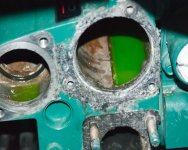I have a 2007 Volvo D2-40 that has crevices corrosion under one of the sealing O-Rings on the rear cap of the heat exchanger manifold. After contacting Volvo North America, their reply was the marine environment is a very harsh place and these issue's are going to happen. One gentleman had 30 hours, I have 353.6 and it is not a consumable part, ($2000.00) is the replacement cost. It is clearly a design flaw, as no cast iron can come in contact with salt water or we all know the out come, and there are no zinc's on these models the D1-D2 series, to even if by chance, salt water entered the block galvanic corrosion would not be an issue. Having said that, I have cross contamination of salt and coolant inside the block. I as well as anyone else would do, started it once a week when not in use, there is no lay up in Southern Cal, so its just part of the weekly maintenance, get it up to temp, check all fittings, we all know the drill with a new, at that time, engine. I provide annual maintenance as well, all fluids are changed prior to the summer season. However, look forward to having the same issue as I with this design, as they will all sue-come to this problem at some time in their life. Its just a very poor flaw that Volvo will not back, unless under warranty. I'd like to here from others whom have had the same experience as I. My repair approach is Permatex Red High Temp RTV Gasket Maker to isolate the cast iron from the salt water and hope it works. As the damage that has been done is quite extensive on the sealing surfaces. If it does leak, JB Weld is the next attempt at resolution. And I do have on board and in the electrical system a Galvanic Isolator, just in case, purchased new along with a lot of every thing that a new engine install requires. Would like to here replies.
Rollo, Fair winds
Rollo, Fair winds

Last edited:

